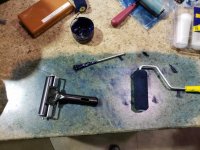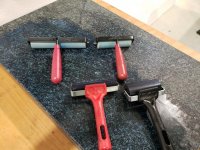If you do much scraping, you will rapidly (or at least I do) find that as with nearly anything besides cleaning a public commode, the gloves cause more hassle than they help. Very hard to work in them, and in some ways MORE staining material gets left in odd places around.
I do as little scraping as I can get away with, actually!

No apologies. I don't actually class it as "entertainment" nor a never-ending saga of time wasted. You doos only what you
must.
I'll presume you follow the Herman King methods, then?
I do not.
Given that Herr Pelz taught an
entirely different way of restoring a worn surface? His own? Learned from others? Never even crossed my mind to ask! So similar to how stone was worked I wasn't aware there had ever BEEN any other way at the time.

Sooo... I'll grant that I probably have but
ten-percent as much handling of, or exposure to, spotting compound as the Herman King regime requires for any given surface.
None of it EVER gets spread directly onto a surface plate, for example.
Ever.
If-even one HAS a surface plate. Given it is actually "optional".
Not interested in arguing with "newer" fossils over the methods
they consider some sort of "religion", but...
I SUSPECT the more efficient method was driven by First World War SHORTAGES? Germany was starving. For real, not as a figure of speech. And had gone bankrupt. A Mercedes aero engine was taking longer to build than it had days if not mere hours - to live once put into the air.
War over, Germany's aero industry was basically shut DOWN. So much for his immediate postwar role in fuel-injection and supercharger R&D prototype crafting.
Herr Pelz found work scraping-in brand new large lathes. Which were being shipped not to German factories but to American ones, rather. As "War Reparations". At the expense of a bankrupt and hungry Germany! Not to the recipient.
Weimar Reich a hungry disaster inflating? He figured if the brand-new machine tools were going to a new future in America? That's where his new future was as well.
Sold his prized Mannlicher rifle with "hook" mounted 'scope for a WHEELBARROW load of paper currency. Beat-feet directly to where his bride was holding a place in line at the steamship office. Bought one-way passage for two, and it was not "First Class".
Desperation drives ingenuity.
Next time he set foot in Germany? It was to take delivery at the factory of a brand-new Mercedes 4-door luxury sedan, tour Western Europe.. so it could be imported at lower tariffs.. as a "used car".

His "backwards" method works well even in time of plenty, needs but a fraction of the physical effort, makes near-zero mess,
and saves
time?
Why, ever, would I give any of that up to play French pigmented finger-painting artist, develop "belly push" muscles, and "always feel with bare hands"?
Not as if it was my WIFE that was worn out of line or plane is it?
As happens, I am
more than delighted there ain't a flat surface
anywhere on the lovely gal!









